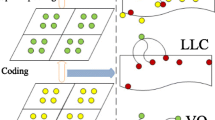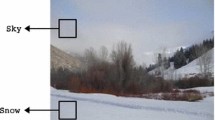Abstract
Image classification could be treated as an effective solution to enable keyword-based semantic image retrieval. In this paper, we propose a novel image classification framework by learning semantic concepts of image categories. To choose representative features for an image category and meanwhile reduce noisy features, a three-step salient feature selection strategy is proposed. In the feature selection stage, salient patches are first detected and clustered. Then the region of dominance and salient entropy measures are calculated to reduce non-common salient patches for the category. Based on the selected visual keywords, SVM and keyword frequency model categorization method are applied to classification, respectively. The experimental results on Corel image database demonstrate that the proposed salient feature selection approach is very effective in image classification and visual concept learning.
This work was performed when the author Feng Xu was visiting Microsoft Research Asia.
Preview
Unable to display preview. Download preview PDF.
Similar content being viewed by others
References
Vailaya, A., Jain, A., Zhang, H.J.: On Image Classification: City vs. Landscape. Pattern Recognition 31(12), 1921–1935 (1998)
Szummer, M., Picard, R.: Indoor-outdoor image classification. In: IEEE International Workshop on Content-based Access of Image and Video Databases, pp. 42–51 (1998)
Fergus, R., Perona, P., Zisserman, A.: Object Class Recognition by Unsupervised Scale-Invariant Learning. In: Proceedings of the IEEE Computer Society Conference on Computer Vision and Pattern Recognition, pp. II/264-II/271 (2003)
Fei-Fei, L., Fergus, R., Perona, P.: A Bayesian Approach to Unsupervised One-Shot Learning of Object Categories. In: Proceedings of the IEEE International Conference on Computer Vision, pp. 1134–1141 (2003)
Fergus, R., Perona, P., Zisserman, A.: A Visual Category Filter for Google Images. In: Proceedings of the 8th European Conference on Computer Vision, pp. 242–256 (2004)
Csurka, G., Dance, C.R., Fan, L., Willamowski, J., Bray, C.: Visual Categorization with Bags of Keypoints. In: The 8th European Conference on Computer Vision - ECCV 2004, pp. 11–14 (2004)
Benitez, A.B., Chang, S.-F.: Image Classification using Multimedia Knowledge Networks. In: IEEE International Conference on Image Processing, pp. 613–616 (2003)
Fan, J., Gao, Y., Luo, H.: Multi-Level Annotation of Natural Scene Using Dominant Image Components and Semantic Concepts. In: MM 2004, pp. 540–547 (2004)
Sivic, J., Zisserman, A.: Video Google: A Text Retrieval Approach to Object Matching in Videsos. In: Proceedings of the Ninth IEEE International Conference on Computer Vision, ICCV 2003 (2003)
Blei, D.M., Jordan, M.I.: Modeling Annotated Data. In: SIGIR 2003, pp. 127–134 (2003)
Blei, D.M., Ng, A.Y., Jordan, M.I.: Latent Dirichlet Allocation. Journal of Machine Learning Research 3, 993–1022 (2003)
Vasconcelos, N., Vasconcelos, M.: Scalable Discriminant Feature Selection for Image Retrieval and Recognition. In: CVPR (2004)
Liu, Y., Collins, R.T.: A Computational Model for Repeated Pattern Perception using Frieze and Wallpaper Groups. In: CVPR 2000 (2000)
Kadir, T., Brady, M.: Scale, saliency and image description. IJCV 45(2), 83–105 (2001)
Lowe, D.G.: Object Recognition from Local Scale-Invariant Features. In: Proc. of the International Conference on Computer Vision (1999)
Vapnik, V.: Statistical Learning Theory. Wiley, Chichester (1998)
Author information
Authors and Affiliations
Editor information
Editors and Affiliations
Rights and permissions
Copyright information
© 2005 Springer-Verlag Berlin Heidelberg
About this paper
Cite this paper
Xu, F., Zhang, L., Zhang, YJ., Ma, WY. (2005). Salient Feature Selection for Visual Concept Learning. In: Ho, YS., Kim, H.J. (eds) Advances in Multimedia Information Processing - PCM 2005. PCM 2005. Lecture Notes in Computer Science, vol 3767. Springer, Berlin, Heidelberg. https://doi.org/10.1007/11581772_54
Download citation
DOI: https://doi.org/10.1007/11581772_54
Publisher Name: Springer, Berlin, Heidelberg
Print ISBN: 978-3-540-30027-4
Online ISBN: 978-3-540-32130-9
eBook Packages: Computer ScienceComputer Science (R0)




